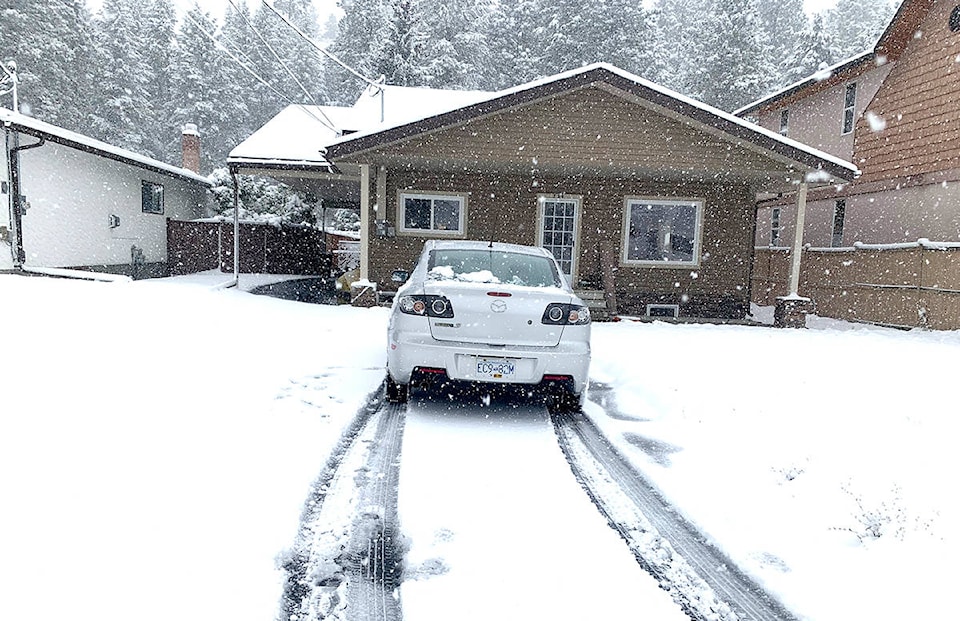Tuesday’s snowstorm came in cold and quick and brought with it a shocking 8.4 centimetres of snow that afternoon, breaking a daily record for snowfall going all the way back to 1901.
In fact, just to put it in comparison the Canadian Rockies International Airport usually records about 3.8 centimetres for the entire month of October, so we got nearly twice the normal amount for the month in just one afternoon. Both the Kimberley and Fernie ski hills picked up 20 centimetres with the cold front.
This was all due to a cold, aggressive cold front that pushed through the East Kootenay, a stark contrast to the sunny skies experienced here over the weekend just a couple short days prior, according to Environment Canada meteorologist Matt McDonald.
“We started the day off at 4 C and the temperature dropped throughout the day to reach -2 C by 5 p.m.” McDonald said. “Initially, it started off as showers, but with that cold front pushing through it switched over to snow by about 1 p.m.”
After a gorgeous weekend, temperatures plunged with the cold front and have stayed low. On Wednesday the high was just 0.9 C, whereas normal highs for this time of year are 14 C. Wednesday night dropped down to -9.3 C, well below the average of 0.
Over the next few days, temperatures will bounce back slightly, with sunshine and the daytime highs gradually climbing, however they will hover around the 6 to 7 C range, well below normal for this time of year, so this cold stretch is not over yet.
“We have a weak system that’s going to push through on Sunday afternoon through Sunday night and we’ll probably see a couple centimetres of wet snow with that one,” McDonald said. “So anyone who’s planning on travelling this Thanksgiving weekend, we’re not expecting a major snowfall here, but be prepared for a little bit more snow perhaps.”
October 1 marked the beginning date for mandatory snow tires, and McDonald reiterated this point, saying, “It’s not just about the snow — the all-season tires, they don’t work quite as well in these cold temperatures.”
Thursday saw a low of -7 C with a low of -4 C for Friday night, so the temperatures are certainly something to consider. He also recommended winterizing your house if you haven’t already done so. Turn off those outside taps and store the hoses for winter.
On the heels of the Townsman’s interview with McDonald came a release from Mainroad Communications, highlighting the importance of being prepared for the unpredictability of fall and winter.
“Please don’t wait until weather conditions deteriorate,” read the release. “Whether you’re driving across town, or across the Province, it’s important that you and your vehicle are prepared for winter driving conditions.”
Mainroad provided five actions for drivers to take to help reduce the risk of a winter driving crash.
First, prepare yourself and your vehicle for the winter conditions now. As Tuesday’s snowfall demonstrated, winter conditions can pop out of nowhere. Don’t want until snow, black ice, heavy rain, longer periods of darkness have already hit, make sure your car is ready now. Equip winter tires, and get a pre-season maintenance check up done.
Also make sure to have a set of first-aid supplies and a winter survival kit. More information on building a complete winter survival kit can be found at www.shiftintowinter.ca
Number two on the list is to determine whether driving for work is necessary. If you’re able to complete your work through email, conference calls, online meetings, courier or public transit, it’s something to consider. Obviously not a possibility for everyone.
Next up, always check road and weather conditions on www.drivebc.ca to assess whether it is safe to drive or not. Sometimes cancelling or rescheduling a trip is better than risking an unsafe drive on the highway.
Always plan your trip ahead. Plan the safest route, make sure you know about alternate routes in case of closures or inclement conditions. Plan time for rest breaks and never drive if you’re is fatigued. Winter driving requires complete alertness and focus.
And five on the list is to simply drive safely. Slow down, remember the posted speed limit is the maximum speed allowed under ideal conditions.
“Drivers have a legal responsibility to drive according to the conditions, which often means driving below the posted speed limit,” Mainroad explains. “Reducing your speed will allow you more time to react to hazards such as black ice or pedestrians at intersections.”
Other driving tips to consider is to maintain a safe following distance as it takes longer to stop on a slippery road. Keep plenty of distance between you and other cars, at least four seconds worth. Also consider winter driving training if you’re unsure how to handle braking safely and getting out of a skid.
paul.rodgers@cranbrooktownsman.com
Like us on Facebook and follow us on Twitter
